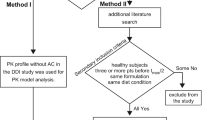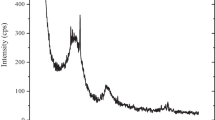Abstract
The in vivo phenobarbital removal characteristics of three brands of activated charcoal (Actidose, Charcoaid, Superchar) were studied in normal volunteers using a system analysis approach. The subjects received a 200-mg dose of oral or intravenous phenobarbital followed by a single oral dose of 30 g of one of the three charcoals in a randomized crossover design. The relative merits of the three charcoals in enhancing the removal of oral and intravenous phenobarbital were assessed using a system analysis approach. The removal clearance, time to peak (t p), peak removal clearance (R max), percentage of dose removed (PCT∞), and phenobarbital removal clearance (CLr) were calculated for the oral and intravenous treatments. Superchar had a pulse-like effect, with the shortest t p and the largest R max. Actidose and Charcoaid had similar effects, with Actidose inducing slightly greater phenobarbital removal. Superchar has the highest surface area and relative percentage of surface hydroxyl groups, whereas Actidose has the lowest surface area and relative percentage of surface hydroxyl groups of the three charcoals studied. Although correlations between the in vitro and the in vivo phenobarbital adsorption characteristics of the three charcoals may be difficult due to the presence of preservatives and palatibility enhancers in the commercial preparations, it appears that the in vivo effectiveness decreases as the surface area and the concentration of surface hydroxyl groups decrease. The proposed system analysis approach requires fewer assumptions than methods based on compartmental or physiologic approaches and has the advantage of describing the phenobarbital removal in a dynamic manner.
Similar content being viewed by others
REFERENCES
T. Litovitz and J. C. Veltri. 1984 annual report of the American Association of Poison Control Centers National Data Collection System. Am. J. Emerg. Med. 3:423–450 (1985).
J. G. Setter, J. F. Maher, and G. E. Schreiner. Barbiturate intoxication: Evaluation of therapy including dialysis in a large series selectively referred because of severity. Arch. Intern. Med. 117:224–236 (1966).
J. B. Costello and A. Poklis. Treatment of massive phenobarbital overdose with dopamine diuresis. Arch. Intern. Med. 141:938–940 (1981).
R. H. Mychetzky and N. A. Lassen, Forced diuresis in treatment of acute barbiturate poisoning. In H. Matthew (ed.), Acute Barbiturate Poisoning, Excerpta Medica, Amsterdam, 1971, pp. 195–204.
M. J. Berg, W. G. Berlinger, M. J. Goldberg, R. Spector, and G. F. Johnson. Acceleration of the body clearance of phenobarbital by activated charcoal. N. Engl. J. Med. 307:642–644 (1982).
M. J. Berg, J. Q. Rose, D. E. Wurster, S. Rahman, R. W. Fincham, and D. D. Scheottelius. Effect of charcoal and sorbitol-charcoal suspension on the elimination of intravenous phenobarbital. Ther. Drug Monit. 9:41–47 (1987).
D. A. R. Boldy, J. A. Vale, and L. F. Prescott. Treatment of phenobarbitone poisoning with repeated oral administration of activasted charcoal. Q. J. Med. 235:997–1002 (1986).
P. J. Neuvonen and E. Elonen. Effect of activated charcoal on absorption and elimination of phenobabitone, carbamezapine and phenylbutazone in man. Eur. J. Pharmacol. 17:51–57 (1980).
H. Yatzidis. The use of ion exchange resins and charcoal in acute barbiturate poisoning. In H. Matthew (ed.), Acute Barbiturate Poisoning, Excerpta Medica, Amsterdam, 1971, pp. 195–204.
E. P. Krenzelok and M. B. Heller. Effectiveness of commercially available aqueous activated charcoal products. Ann. Emerg. Med. 16:1340–1343 (1987).
E. P. Krenzelok and R. M. Lush. Container residue after the administration of aqueous activated charcoal products. Am J. Emerg. Med. 9:144–146 (1991).
C. D. Curd-Sneed, L. E. McNattle, and J. L. Stewart. Absorption of sodium pentobarbital by three types of activated charcoal. Vet. Hum. Toxicol. 28:524–526 (1986).
A. L. Piccioni, L. Chin, and H. E. Liard. Activated charcoal preparations: Relative antidotal efficacy. Clin. Toxicol. 28:524–526 (1974).
W. R. Gillespie, P. Veng-Pedersen, M. J. Berg, and D. D. Schottelius. Linear systems approach to the analysis of an induced drug removal process. Phenobarbital removal by oral activated charcoal. J. Pharmacokin. Biopharm. 14:19–28 (1986).
W. E. Gillespie, P. Veng-Pedersen, and T. P. Gibson. Deconvolution applied to the kinetics of extracorporeal drug removal. Haemodialysis of cefsulodin. Eur. J. Clin. Pharmacol. 29:503–509 (1985).
D. D. Schottelius. Homogeneous immunoassay system (EMIT) for quantitation of antiepileptic drugs in biological fluids. In C. E. Pippenger, J. K. Perry, and H. Kutt (eds.), Antiepileptic Drugs: Quantitative Analysis and Interpretation, Raven Press, New York, 1978, pp. 95–108.
D. J. Cutler, Linear system analysis in pharmacokinetics. J. Pharmacokin. Biopharm. 6:265–282 (1978).
P. Veng-Pedersen. Curve fitting and modeling in pharmacokinetics and some practical experience with NONLIN and a new program FUNFIT. J. Pharmacokin. Biopharm. 5:513–531 (1977).
J. Alvin. The effect of liver disease in man on the disposition of phenobarbital. J. Pharmacol. Exp. Ther. 192:224–235 (1975).
G. Levy. Gastrointestinal clearance of drugs with activated charcoal. N. Engl. J. Med. 307:676–678 (1982).
K. Arimori, Y. Hashimoto, and M. Nakano. Comparison of intestinal and peritoneal dialysis of theophylline and phenobarbitone in rats. J. Pharm. Pharmacol. 42:726–728 (1990).
G. M. Burke, D. E. Wurster, M. J. Berg, P. Veng-Pedersen, and D. D. Schottelius. Surface characterization of activated charcoal by x-ray photoelectron spectroscopy (XPS): Correlation with phenobarbital adsorption data. Pharm. Res. 9:126–130 (1992).
G. M. Burke, D. E. Wurster, V. Buraphacheep, M. J. Berg, P. Veng-Pedersen, and D. D. Schottelius. Model selection for the adsorption of phenobarbital by activated charcoal. Pharm. Res. 8:228–231 (1991).
D. E. Wurster, G. M. Burke, M. J. Berg, P. Veng-Pedersen, and D. D. Schottelius. Phenobarbital adsorption from simulated intestinal fluid, U.S.P., and simulated gastric fluid, U.S.P., by two activated charcoals. Pharm. Res. 5:183–186 (1988).
T. F. Eisen, P. A. Grbcich, P. G. Lacouture, M. W. Shannon, and A. Woolf. The adsorption of salicylates by a milk chocolate-charcoal mixture. Ann. Emerg. Med. 20:143–146 (1991).
L. Chin, A. Picchioni, W. M. Bourn, and H. E. Laird. Optimal antidotal dose of activated charcoal. Toxicol. Appl. Pharmacol. 26:103–108 (1973).
N. Barzaghi, G. Gatti, R. Manni, C. A. Galimberti, C. Zucca, E. Perucca, and A. Tartara. Comparative pharmacokinetics and pharmacodynamics of eterobarbital and phenobarbital in normal volunteers. Eur. J. Drug Metab. Pharmacokin. 16:81–87 (1991).
Author information
Authors and Affiliations
Rights and permissions
About this article
Cite this article
Modi, N.B., Veng-Pedersen, P., Wurster, D.E. et al. Phenobarbital Removal Characteristics of Three Brands of Activated Charcoals: A System Analysis Approach. Pharm Res 11, 318–323 (1994). https://doi.org/10.1023/A:1018980029882
Issue Date:
DOI: https://doi.org/10.1023/A:1018980029882




